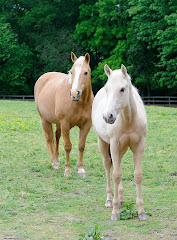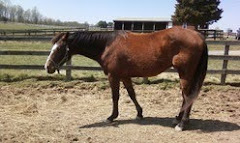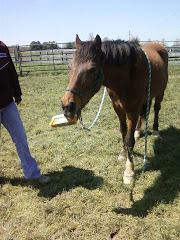Recently I’ve been thinking about thresholds and reflecting on how my ideas about thresholds have changed since I began studying Parelli Natural Horsemanship four years ago. When I was younger, I pretty much considered thresholds to be something that brides were carried over on their wedding day. Later, as I pursued my studies in chemistry, I expanded my thinking about thresholds to include the limit below which a chemical substance could not be detected. I never considered a threshold as something that had a psychological meaning and when I first heard Linda Parelli talking about not pushing your horse past thresholds, I was still thinking about them in more physical terms. It wasn’t until I met a young quarter horse by the name of Hershey’s American Hero that the light bulb finally turned on in my mind.
Hero was a four month old cremello colt that had been rescued from the Camelot kill pens in New Jersey. He arrived at the rescue, thin, sickly and shy and had to be doctored back to health by a combination of good food, good care from our veterinarian and lots of love from the volunteers. Assisting in Hero’s rehabilitation was our director’s mare, Bugsy. Bugsy is an aged quarter horse with a strong mothering instinct and she has fostered every foal brought to the rescue. She immediately became Hero’s protector and he followed her around as if she was his own mother. She stayed by his side as he fought his way through a nasty respiratory infection even sharing his runny nose for some time.
Because Hero was so cute, he received lots of attention from the volunteer staff and after a few months at the rescue he was well on his way to being tamed. He would allow himself to be haltered and groomed and his ground manners were admirable considering how much he was fussed over on a daily basis but he would not allow himself to be led. This hadn’t really posed a problem for the volunteers so far because if anyone wanted to move Hero from place to place, all they had to do was to lead Bugsy and he would follow along. But Hero was growing quickly and the rescue’s director knew that so we would need to be able to lead him independently of his foster mother.
Teaching Hero to lead became my summer project. Because he was so tame, catching him was not an issue and he would allow me to slip the halter on his head, even turning his nose in my direction as I positioned it and tied the knot. I started by making sure my friendly game was solid and then would ask him to take just a step or two away from Bugsy. He quickly learned what the pressure from the halter meant and soon I was able to lead him in circle around Bugsy. I kept our sessions short, gradually increasing the distance I asked him to walk and although I hadn’t tried to lead him completely away from the herd, I felt I was making good progress.
One afternoon, as I was headed out to the field for another session with Hero, our barn manager Meredith called to me. “If you’re going to get Hero,” she said, “Could you bring him back to the barn? The vet is coming to see him.”
Hero and Bugsy were in the front field. It was separated from the field around the barn by a double fence. In the daytime, we opened both gates between the two fields, forming a chute the horses passed through on their way out. Because the horses preferred the grass in the front pasture, they were always in that field whenever the gates were opened. While it was only perhaps a couple of hundred yards from the front pasture to the barn, I would have to lead Hero away from Bugsy and the herd, through the chute and then through another gate and I knew that might be a challenge for the little fellow.
I slipped Hero a treat as I put the halter on and then gave him a good scratch before starting away from Bugsy. Standing at his side, I asked him to go forward with a slight pressure on the halter and a kiss. Hero took a few steps and then stopped, looking around for Bugsy. I scratched his neck, waited for him to look back at me and then asked him to more forward again. He took a few more steps and stopped so I repeated the wait and the scratch and in this way we walked out of the front field and through the chute into the barn field. It was slow going and although I could see that Hero was a bit concerned about being asked to move so far away from his herd, he wasn’t really agitated. When he would stop, I would stop and I waited to make sure he was with me before I asked him to move forward again. I was trying to be really careful about not forcing him forward but I wasn’t really thinking in terms of thresholds.
We made it all the way to the next gate before we hit the wall. Hero walked through gates all the time at the rescue and although I knew gates presented a squeeze, I wasn’t all that concerned. When I opened the gate and asked Hero to move forward, he actually planted his feet and pulled back against the halter. “This is different,” I thought to myself and I quickly let up on the pressure and studied the situation. That was when I recognized the first threshold, a physical one.
Some of our horses are fed at buckets that hang on the fence adjoining this gate, so the ground is pretty bare in that spot and is the rich red color of the dominant clay in the soil. On the other side of the gate in that spot, there is a thick, green carpet of grass and right at the gate, there is a small, 2 to 3 inch difference in the ground so that a horse has to step up slightly when going from field to grass. Because horses notice changes, I could see how this could present a problem to Hero. While he walked through gates all the time, he seldom faced this particular situation. I was asking him to “squeeze” through this gate and go across this physical threshold all at once.
Figuring that approach and retreat would probably be appropriate in this situation, I led Hero away and waited for him to relax. When he finally dropped his head, I turned him around and approached the gate again. This time he came a little closer. We repeated this a few times but when I finally tried to encourage him with a slight increase in pressure on the lead line, instead of moving forward he reared straight up. He was well and truly stuck and I was beginning to think there was more to this threshold then just the physical line in the clay that the color change presented.
I was standing at the gate scratching Hero’s neck and trying to figure out what to do next when Hannah, one of our younger volunteers, walked up. Wondering if a little pressure from behind might encourage Hero forward, I asked Hannah to take a spare lead line, go behind Hero and twirl it. Because I didn’t want Hero to feel too much pressure, I told Hannah to stand well away from Hero and I also asked her not to face him. She started twirling the line and Hero craned his neck around to see what was going on behind him. Then I asked Hero to step forward. He hesitated but he didn’t rear up. That was a good sign. He swiveled his head around again to look at Hannah. The next time I asked him to step forward he popped through gate with a small jump and came to rest at the other side, first looking back at where he had just come from and then looking directly at me. He gave himself a shake and began licking and chewing, nodding his head up and down a couple of times while he did.
I stood next to Hero, scratching his neck and giving him all the time he needed to process what had just happened. Finally his breathing became regular and he dropped his head for a bite of grass. When I finally asked Hero to walk forward with me he stepped off immediately and he walked quietly at my shoulder the rest of the way back to the barn. He led beautifully, making no attempt to stop again for the remainder of our journey and walking through the next gate without any hesitation. I handed him over to Meredith and as I watched her lead him away toward a stall, it occurred to me that it wasn’t just a physical threshold that Hero had encountered at that other gate, it was a psychological threshold as well.
For the entire walk in from the front pasture, I think Hero had been experiencing a series of psychological thresholds that had to do with leaving his herd. Each time he stopped, he had reached a threshold and each time I asked him to go forward, I was causing him to cross the threshold. I think the pressure was building up for him until we finally reached the gate. At that point, the combination of the squeeze at the gate, the physical threshold between the clay and the grass and the psychological threshold of leaving the herd built up to the point that Hero became stuck. When he finally crossed through the gate without anything bad happening, it was a significant moment to him. I think at that point, he truly accepted me as a leader and therefore it became OK to move away from the horse herd because he finally understood that we were a herd of two and that I wasn’t going to let anything bad happened to him. That was the moment when Hero really learned how to be led and I learned that psychological thresholds can be every bit as real as physical ones.
Since that time, I have become a lot more sensitive to the idea of psychological thresholds for my own horse Sonny. Because he is a calm and relatively brave LBI, his reactions are a lot more subtle than Hero’s were so it has not always been easy to recognize when he has reached a threshold but I have been working hard to understand them and that has helped continue to strengthen our bond. I have also experienced my own psychological thresholds as I’ve begun to ride my horse Sonny bareback and because I can recognize them for what they are, I am able to use approach and retreat as a way to help myself across.
Tuesday, January 24, 2012
Subscribe to:
Posts (Atom)






